Intel Core i7 3820 Review: $285 Quad-Core Sandy Bridge E
by Anand Lal Shimpi on December 29, 2011 2:28 AM EST- Posted in
- CPUs
- Intel
- Sandy Bridge
- Sandy Bridge E
If you are a normal desktop user or even a power user with plans to run at over 4GHz, the vanilla LGA-1155 Sandy Bridge platform is good enough. You get some of the fastest CPUs on the market today paired with reasonably priced motherboards and the ability to use Quick Sync to transcode video...er...quickly. If that's not enough, Intel launched a higher end platform last month: the LGA-2011 Sandy Bridge E.
Take a regular Sandy Bridge, add PCIe 3.0 support, increase the number of PCIe lanes that branch off of the CPU (from 16 to 40 lanes), double the number of memory channels (4 x 64-bit DDR3 memory controllers) and you've got Sandy Bridge E and its LGA-2011/X79 platform. SNB-E is currently available in two forms: a $999 6-core Extreme Edition part (Core i7 3960X) and a $555 6-core unlocked version (Core i7 3930K). Neither is exactly cheap but if you need the PCIe lanes, core count and memory bandwidth, they are your only ticket.
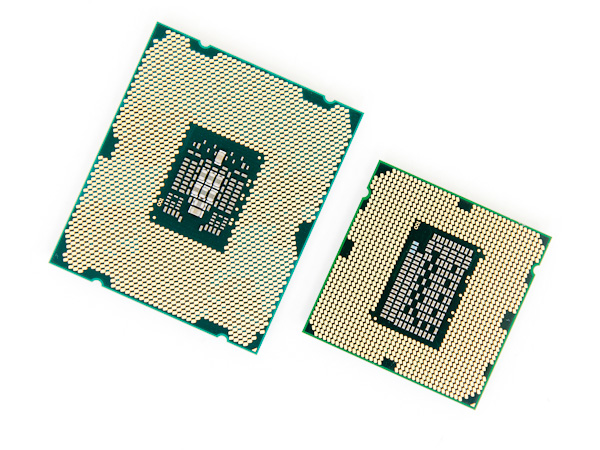
LGA-2011 SNB-E (left) vs. LGA-1155 SNB (right)
Sandy Bridge E is a fairly niche platform to begin with, but what about the niche within the niche (extremeception?) of users who just need the LGA-2011 platform but not necessarily a 6-core behemoth? For those users, there's the Core i7 3820:
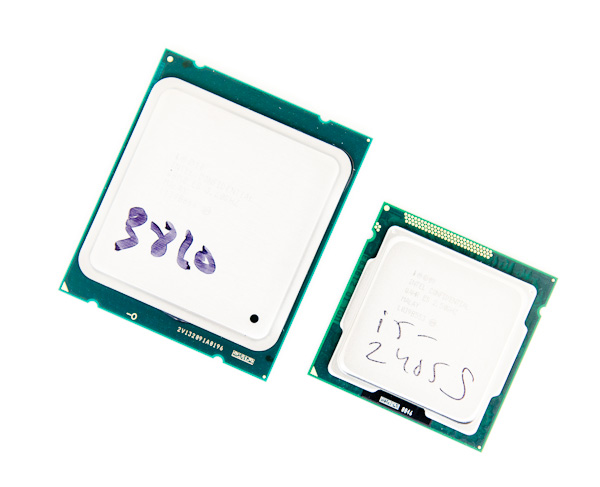
LGA-2011 SNB-E (left) vs. LGA-1155 SNB (right)
The Core i7 3820 is the first (and only) quad-core Sandy Bridge E CPU. It's so new that the chip isn't even available for sale nor will it be until early 2012. Unlike the relationship between the 3960X and 3930K, the 3820 is an entirely new die.
The chip features four Sandy Bridge cores and is paired with a 10MB L3 cache, giving it a slight advantage over the highest end LGA-1155 Sandy Bridge CPUs on the market today. The result is a die that's bigger than a regular SNB but significantly smaller than a 6-core SNB-E:
| CPU Specification Comparison | ||||||||
| CPU | Manufacturing Process | Cores | Transistor Count | Die Size | ||||
| AMD Bulldozer 8C | 32nm | 8 | 1.2B | 315mm2 | ||||
| AMD Thuban 6C | 45nm | 6 | 904M | 346mm2 | ||||
| AMD Deneb 4C | 45nm | 4 | 758M | 258mm2 | ||||
| Intel Gulftown 6C | 32nm | 6 | 1.17B | 240mm2 | ||||
| Intel Sandy Bridge E (6C) | 32nm | 6 | 2.27B | 435mm2 | ||||
| Intel Sandy Bridge E (4C) | 32nm | 4 | 1.27B | 294mm2 | ||||
| Intel Nehalem/Bloomfield 4C | 45nm | 4 | 731M | 263mm2 | ||||
| Intel Sandy Bridge 4C | 32nm | 4 | 995M | 216mm2 | ||||
| Intel Lynnfield 4C | 45nm | 4 | 774M | 296mm2 | ||||
| Intel Clarkdale 2C | 32nm | 2 | 384M | 81mm2 | ||||
| Intel Sandy Bridge 2C (GT1) | 32nm | 2 | 504M | 131mm2 | ||||
| Intel Sandy Bridge 2C (GT2) | 32nm | 2 | 624M | 149mm2 | ||||
There's a small improvement in base clock frequency over the fastest SNB (3.6GHz vs. 3.5GHz) but max turbo remains unchanged at 3.9GHz. For single threaded applications the 3820 should be just as fast as a Core i7 2700K or a 3960X. The same is true for if all heavily threaded workloads, at least when compared to other quad-core parts (the 3960/3930 still maintain an advantage because of their two additional cores).
| Processor | Core Clock | Cores / Threads | L3 Cache | Max Turbo | Max Overclock Multiplier | TDP | Price |
| Intel Core i7 3960X | 3.3GHz | 6 / 12 | 15MB | 3.9GHz | 57x | 130W | $990 |
| Intel Core i7 3930K | 3.2GHz | 6 / 12 | 12MB | 3.8GHz | 57x | 130W | $555 |
| Intel Core i7 3820 | 3.6GHz | 4 / 8 | 10MB | 3.9GHz | 43x | 130W | $285 |
| Intel Core i7 2700K | 3.5GHz | 4 / 8 | 8MB | 3.9GHz | 57x | 95W | $332 |
| Intel Core i7 2600K | 3.4GHz | 4 / 8 | 8MB | 3.8GHz | 57x | 95W | $317 |
| Intel Core i7 2600 | 3.4GHz | 4 / 8 | 8MB | 3.8GHz | 42x | 95W | $294 |
| Intel Core i5 2500K | 3.3GHz | 4 / 4 | 6MB | 3.7GHz | 57x | 95W | $216 |
| Intel Core i5 2500 | 3.3GHz | 4 / 4 | 6MB | 3.7GHz | 41x | 95W | $205 |
There's no on-die GPU, no heatsink/fan in the box and this isn't a fully unlocked part so the 3820 is actually cheaper than most of the high-end Sandy Bridge CPUs: it's priced at $285. If it weren't for the fact that you'll still need to spend over $200 on a motherboard I would say that the 3820 is a steal.
Overclocking
Let's start with the basics. All Sandy Bridge CPUs are clock locked by default, they can't operate at frequencies other than what they're sold at. There are two exceptions to this rule. All Sandy Bridge CPUs that support Turbo Boost are partially unlocked. Not only can they turbo up to frequencies that are higher than their default clock, but they can also be overclocked to frequencies even higher than their turbo speeds. By default, all Turbo enabled Sandy Bridge CPUs can be set to run at up to four bins (4 * bclk or 400MHz by default) higher than their standard turbo frequencies:
The second exception is any of the K or X-series SKUs. If your Sandy Bridge model number ends in a K or X, then the chip is fully unlocked and can be overclocked up to 5.7GHz using only clock multiplier adjustments.
The Core i7 3960X and 3930K fall into the latter category, which makes overclocking them a breeze. The 3820 on the other hand is partially unlocked, which means that we can run it at up to 4.3GHz using multiplier adjustments alone. Note that the 4.3GHz limit only applies to the 1-core active state, in the worst case scenario of all cores active with no room to turbo the highest operating frequency of the chip when overclocked would be 4.0GHz.
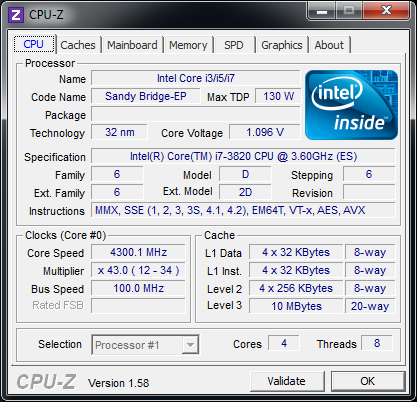
The max 3820 overclock without touching bclk settings
While these aren't bad targets, they're not all that exciting either. Thankfully Sandy Bridge E makes it even easier to overclock through the use of a few higher bclk frequencies. By default Sandy Bridge uses a 100MHz bclk, but SNB-E allows for 125MHz, 166MHz and 250MHz options as well. The 166/250MHz settings are a bit too aggressive, but the 125MHz bclk setting proved to be the perfect companion for the 3820.
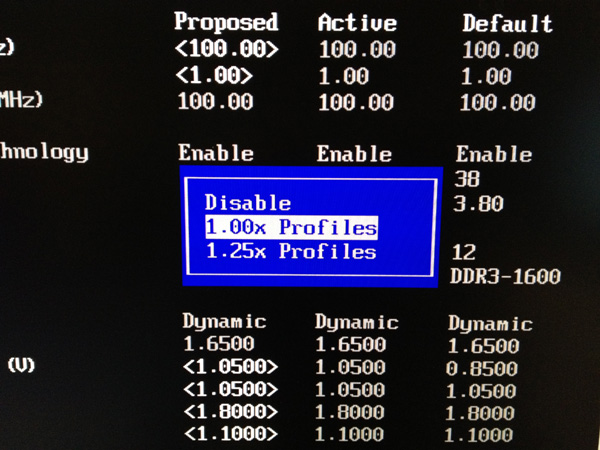
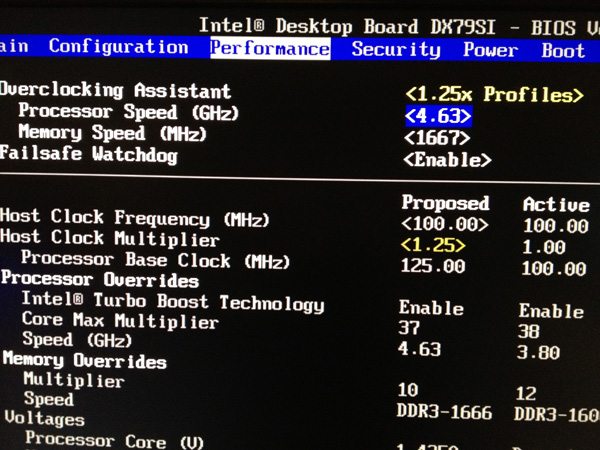
Intel's DX79SI makes it extremely easy to overclock, especially with the latest BIOS update. There are built in overclocking profiles for each bclk setting that you can choose from. I simply selected the 1.25x (125MHz) profile option and then went through the list of target frequencies until I found one that seemed promising. I also went in and tweaked some of the settings myself to get a bit more clock speed (4.63GHz is the fastest profile this board allows by default) and improve stability. In the end I was fairly pleased with what the 3820 could do: 4.75GHz with Intel's RTS2011LC closed loop cooling system.
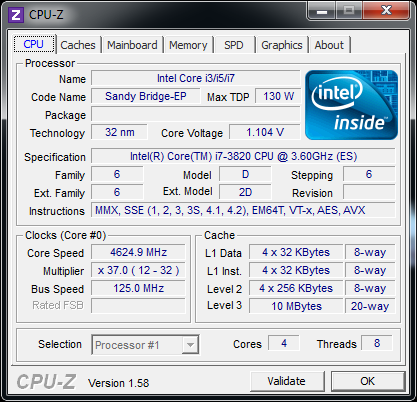
Now we're talking
I couldn't get the 3820 as stable as I would like at 4.88GHz and 5GHz was unfortunately out of the reach of my sample. I can't really complain about 4.75GHz from a $285 chip though, especially without resorting to anything too exotic from a cooling standpoint. Overclocking is also extremely effortless thanks to the new bclk options on SNB-E. Although the Core i7 3820 isn't an unlocked part, that doesn't limit how far (or how easily) it can be overclocked. A big part of the ease of overclocking is due to how good of a job Intel did on the DX79SI BIOS options, but from what we've seen the third party boards also do a decent job of simplifying the process.
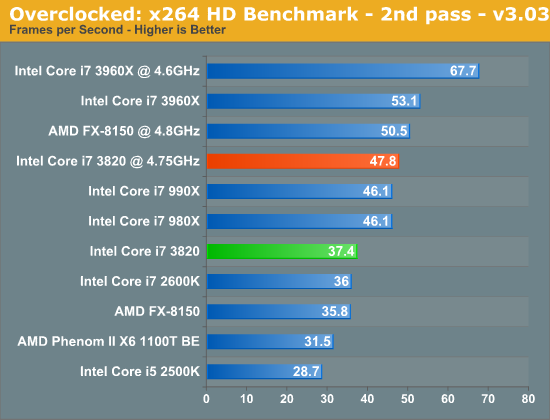
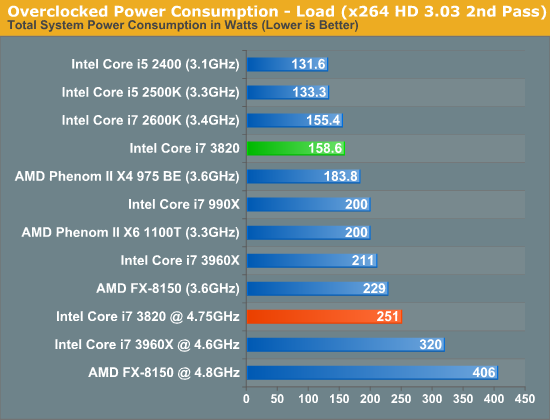
The Test
To keep the review length manageable we're presenting a subset of our results here. For all benchmark results and even more comparisons be sure to use our performance comparison tool: Bench.
| Motherboard: |
ASUS P8Z68-V Pro (Intel Z68) ASUS Crosshair V Formula (AMD 990FX) Intel DX79SI (Intel X79) |
| Hard Disk: |
Intel X25-M SSD (80GB) Crucial RealSSD C300 |
| Memory: | 4 x 4GB G.Skill Ripjaws X DDR3-1600 9-9-9-20 |
| Video Card: | ATI Radeon HD 5870 (Windows 7) |
| Video Drivers: | AMD Catalyst 11.10 Beta (Windows 7) |
| Desktop Resolution: | 1920 x 1200 |
| OS: | Windows 7 x64 |


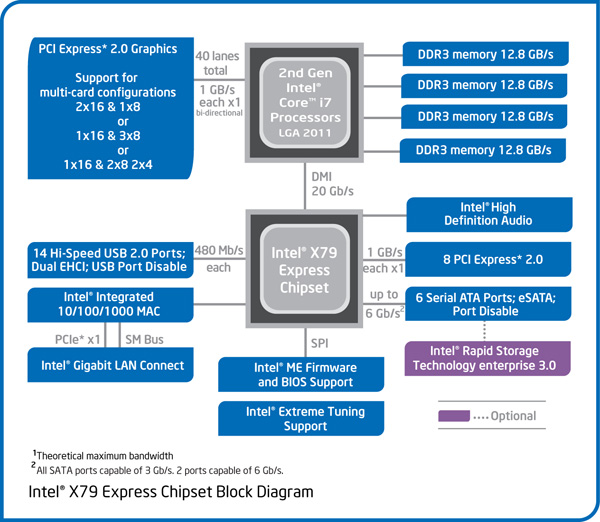









84 Comments
View All Comments
14ccKemiskt - Thursday, December 29, 2011 - link
Exactly. The original line-up for the enthusiast platform (LGA1366) was 920 ($280),940 ($560), 965 ($999). That has since then gradually transformed (by price level)~$280: 920 > 930 > 950 > 960 > 3820
~$560: 940 > 950 > 960 > 970 > 980 > 3930K
~$999: 965 > 975 > 980X > 990X > 3960X
The big "winner" on the enthusiast platform(s) is the $560 part that has gone from being a locked quad-core 2.9 GHz chip to a unlocked hex-core 3.2 GHz one.
But it is fair that the 920 has got it's successor. And if you want a lot of RAM, don't need the internal graphics or want the option to upgrade your cpu, the LGA2011+3820 is as good a choice as the LGA1155+2700K. Remember that we may well see a octa-core IVB-E within a year or so and LGA2011 will be the only platform to put it into.
rgallant - Thursday, December 29, 2011 - link
have a I7-920 and 2 x 580 ,+ 2 x gtx 285's laying around.-down the road might want to use a 3rd card , either a 580 or a gtx 285[phsyx]
-so sb = x8,x4,x4 pci-e 2.0
-so ib = x8,x4,x4 pci-e 2.0 - need all 3.0 cards for x8,x4,x4 pci-e 3.0
-so 40 lanes look's better to me , not = to sb\ib.
-come Jan.09 hope to see some sb benches with 2 x 7970 and a 3rd card at x8,x4,x4, and at x8+x8 ,then some 2 x x16 3.0 + x8 on a 79x system.
-ib will not have a nv200 chip to give more lanes , as it's does not do pci-e 3.0.
DanNeely - Thursday, December 29, 2011 - link
I'd be shocked if nVidia doesn't luanch a PCIe 3.0 successor to the nv200...dj christian - Thursday, January 5, 2012 - link
I did not understand a thing what you just wrotetpi2009 - Friday, December 30, 2011 - link
Hi Anand,could you tell uss what is the latency of 10 MB L3 cache in the i7 3820 ? From the 3960X review the latency for the i7 3930K and 3960X were a bit higher compared to Sandy Bridge, given their bigger size, and also the main memory acess lantecy was also higher .
Given that the i7 3820 is not an eight core chip with disabled cores and cache, I was wondering what latency does the cache and main memory access have ? Close to Sandy Bridge ? Close to the i7 3930K and 3960X ?
Thanks!
HMTK - Friday, December 30, 2011 - link
Looks like a nice cheap CPU for a virtualization setup if it has all the necessary hardware activated.SunLord - Friday, December 30, 2011 - link
Just looking at that transistor count pretty much shows exactly why AMD isn't as good as Intel they keep failing at trying to do more with less. They'd probably have far better luck trying to do more in the same amount of transistorsHauk - Friday, December 30, 2011 - link
Now for the release date..?murray13 - Friday, December 30, 2011 - link
Your 'niche' posit has one big flaw. Not everyone builds a new system every year or even 18 months. Those of us that only build new systems every 3 to 4 years are more looking at the platform and it's longevity than the single generation cpu gains.If someone wants to build a system (in the next couple of months) and needs it to last for 3 or 4 years, LGA2011 sure looks a lot better than LGA1155 does, at least with the current z68 chipset. That may change with the 7x chipset upgrade coming with IVB.
So for me the real question is do I build when the 3820 comes out or do I wait and build when IVB comes out, assuming IVB brings with it a 7x chipset...
I'm leaning heavily right now on LGA2011. Maybe I'm one of those 'niche' people.
descendency - Saturday, December 31, 2011 - link
Nah. Anand is right. The performance gap between SBE and SB isn't big enough in the vast majority of applications (especially consumer applications, ie games). 3-4 years or not.You will only see a performance gap increase at the ultra high end of the markets. Regardless of what year it is. So unless you are predicting that in the next 3-4 years, the ultra high end needs today become the midrange needs of tomorrow (something I would say, from a software engineer's perspective, is far from likely), I'd suggest you buy an SB instead of an SBE.
I'm running a 3 year old AMD system fine. (speaking of which... might be time to upgrade lol)